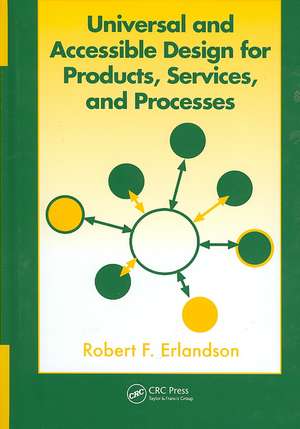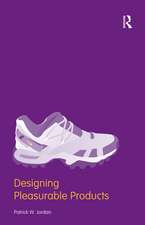Universal and Accessible Design for Products, Services, and Processes
Autor Robert F. Erlandsonen Limba Engleză Hardback – 3 aug 2007
Supplying definitions, theory, and applications, Universal and Accessible Design for Products, Services, and Processes allows professional designers, educators, and students to implement these principles and understand how their application fits a broader societal and competitive design environment.
Preț: 893.73 lei
Preț vechi: 1089.91 lei
-18% Nou
Puncte Express: 1341
Preț estimativ în valută:
171.03€ • 185.72$ • 143.67£
171.03€ • 185.72$ • 143.67£
Carte tipărită la comandă
Livrare economică 22 aprilie-06 mai
Preluare comenzi: 021 569.72.76
Specificații
ISBN-13: 9780849374937
ISBN-10: 0849374936
Pagini: 284
Ilustrații: 61 b/w images, 14 tables and 33 halftones
Dimensiuni: 156 x 234 x 20 mm
Greutate: 0.52 kg
Ediția:1
Editura: CRC Press
Colecția CRC Press
ISBN-10: 0849374936
Pagini: 284
Ilustrații: 61 b/w images, 14 tables and 33 halftones
Dimensiuni: 156 x 234 x 20 mm
Greutate: 0.52 kg
Ediția:1
Editura: CRC Press
Colecția CRC Press
Public țintă
Professional and Professional Practice & DevelopmentCuprins
Introduction and Definitions, The Time Has Come, Design: Universal Design/Accessible, Design/Adaptable Design, Disability, Laws, and Accessible Design, Disability and Design, Accessible Design, Universal Design Principles, Strategies, and Examples, Hierarchical Structure of Universal Design, Principles and Implications for the Design Process, Ergonomically Sound, Perceptible, Cognitively Sound, Flexible, Error-Managed (Proofed), Efficient (Muda Elimination), Equitable: Transcending, Integrating, Universal and Accessible Design in the Workplace, The World Wide Web: Accessibility and Universal Design, Ethical Considerations and Conclusions, Ethics and Universal Design, Universal and Accessible Design from a Social and Political Perspective, Index
Recenzii
"I strongly recommend this text as a supplement to your normal design text, no matter what your engineering field is. The coverage is excellent and should be of value to most undergraduate design classes."
– In IEEE Engineering in Medicine and Biology Magazine, May/ June 2008
– In IEEE Engineering in Medicine and Biology Magazine, May/ June 2008
Descriere
Using clear, approachable examples, this book defines and differentiates accessible versus universal design, and explores their relationship in a broad societal and global context. It focuses on accessible design, including legal mandates, and guidelines from U.S. regulatory and resource agencies. Providing strategies, examples, and applications, it presents universal design principles; explores the expanding conceptualization of universal design; and discusses future directions. After reading this book, readers will be able to apply these principles to their own projects without running afoul of compliance requirements.








